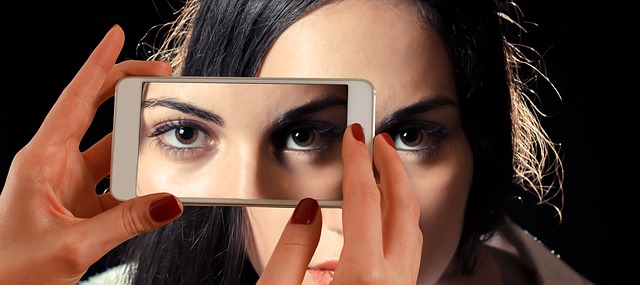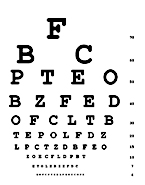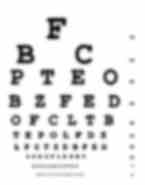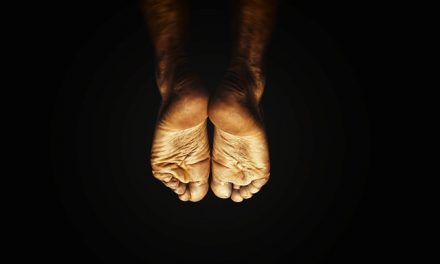Too much sugar in the blood for a long time causes diabetes problems. This high blood sugar can damage many parts of the body, such as the eyes, heart, and blood vessels.
Diabetes problems can be scary, but there is a lot you can do to prevent them or slow them down.
This article is about eye problems caused by diabetes. You will learn the things you can do
each day and during each year to stay healthy and prevent diabetes problems.
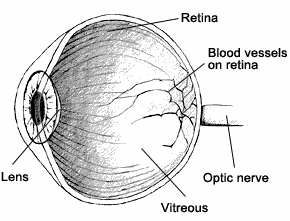 | High blood sugar can cause eye problems. |
Article Menu:
- What should I do each day to stay healthy with diabetes?
- What can I do to prevent diabetes eye problems?
- How can diabetes hurt my eyes?
- How can diabetes hurt the retinas of my eyes?
- What happens as diabetes retina problems get worse?
- What can I do about diabetes retina problems?
- How do I know if I have retina damage from diabetes?
- Does diabetes cause other eye problems?
- For more information
What should I do each day to stay healthy with diabetes?
 | Follow the healthy eating plan that you and your doctor or dietitian have worked out. Eat your meals and snacks at around the same times each day. |
| Be active a total of 30 minutes most days. Ask your doctor what activities are best for you. | |
 | Take your diabetes medicine at the same times each day. |
 | Check your blood sugar every day. Each time you check your blood sugar, write the number in your record book. Call your doctor if your numbers are too high or too low for 2 to 3 days. |
 | Check your feet every day for cuts, blisters, sores, swelling, redness, or sore toenails. |
 | Brush and floss your teeth and gums every day. |
 | Don’t smoke. |
What can I do to prevent diabetes eye problems?
- Keep your blood sugar and blood pressure
as close to normal as you can. - Have an eye doctor examine your eyes once
a year. Have this exam even if your vision is OK. The eye doctor will use drops to make the black part of your eyes (pupils) bigger. This is called dilating (DY-lay-ting) your pupil, which allows the doctor to see your retina. Finding eye problems early and getting treatment right away will help prevent more serious problems later on.
 |  | |
| Dilated eye | Undilated eye |
- Ask your eye doctor to check for signs of cataracts and glaucoma. (See Does diabetes cause other eye problems? to learn more about cataracts and glaucoma.)
- If you are pregnant and have diabetes, see
an eye doctor during your first 3 months. - If you are planning to get pregnant, ask your doctor if you should have an eye exam.
- Don’t smoke
How can diabetes hurt my eyes?
High blood sugar and high blood pressure from diabetes can hurt four parts of your eye:
- Retina (REH-ti-nuh). The retina is the lining
at the back of the eye. The retina’s job is to
sense light coming into the eye. - Vitreous (VIH-tree-us). The vitreous is a jelly-like fluid that fills the back of the eye.
- Lens. The lens is at the front of the eye and it
focuses light on the retina. - Optic nerve. The optic nerve is the eye’s main
nerve to the brain.
 | This is a picture of |
How can diabetes hurt the retinas of my eyes?
Retina damage happens slowly. Your retinas have tiny blood vessels that are easy to damage. Having high blood sugar and high blood pressure for a long time can damage these tiny blood vessels.
First, these tiny blood vessels swell and weaken. Some blood vessels then become clogged and do not let enough blood through. At first, you might not have any loss of sight from these changes. This is why you need to have a dilated eye exam once a year even if your sight seems fine.
One of your eyes may be damaged more than the other. Or both eyes may have the same amount of damage.
Diabetic retinopathy (REH-tih-NOP-uh-thee) is the medical term for the most common diabetes eye problem.
What happens as diabetes retina problems get worse?
As diabetes retina problems get worse, new blood vessels grow. These new blood vessels are weak.
They break easily and leak blood into the vitreous of your eye. The leaking blood keeps light from reaching the retina.
You may see floating spots or almost total darkness. Sometimes the blood will clear out by itself. But you might need surgery to remove it.
Over the years, the swollen and weak blood vessels can form scar tissue and pull the retina away from the back of the eye. If the retina becomes detached, you may see floating spots or flashing lights.
You may feel as if a curtain has been pulled over part of what you are looking at. A detached retina can cause loss of sight or blindness if you don’t take care of it right away.
Call your doctor right away if you think you have
a detached retina.
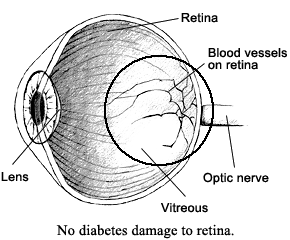 |
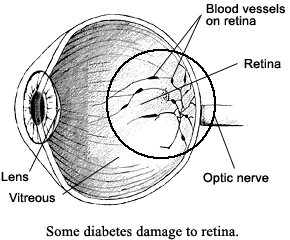 |
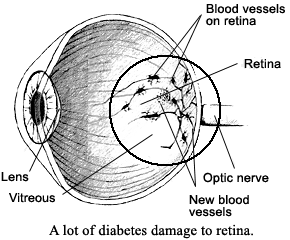 |
What can I do about diabetes retina problems?
First, keep your blood sugar and blood pressure
as close to normal as you can.
Your eye doctor may suggest laser treatment, which
is when a light beam is aimed into the retina of the damaged eye. The beam closes off leaking blood vessels. It may stop blood and fluid from leaking into the vitreous. Laser treatment may slow the loss of sight.
If a lot of blood has leaked into your vitreous and
your sight is poor, your eye doctor might suggest you have surgery called a vitrectomy (vih-TREK-toh-mee). A vitrectomy removes blood and fluids from the vitreous of your eye. Then clean fluid is put back into the eye. The surgery often makes your eyesight better.
How do I know if I have retina damage from diabetes?
You may not get any signs of diabetes retina damage or you may get one or more signs:
- Blurry or double vision
- Rings, flashing lights, or blank spots
- Dark or floating spots
- Pain or pressure in one or both of your eyes
- Trouble seeing things out of the corners of
your eyes.
| If you have retina damage from diabetes, you may have blurry or double vision. |
Does diabetes cause other eye problems?
Yes. You can get two other eye problems–cataracts and glaucoma. People without diabetes can get these eye problems, too. But people with diabetes get them more often and at a younger age.
- A cataract (KA-ter-act) is a cloud over the lens of your eye, which is usually clear. The lens focuses light onto the retina. A cataract makes everything you look at seem cloudy. You need surgery to remove the cataract. During surgery your lens is taken out and a plastic lens, like a contact lens, is put in. The plastic lens stays in your eye all the time. Cataract surgery helps you see clearly again.
- Glaucoma (glaw-KOH-muh) starts from pressure building up in the eye. Over time, this pressure damages your eye’s main nerve–the optic nerve. The damage first causes you to
lose sight from the sides of your eyes. Without treatment, you can go blind. Treating glaucoma is usually simple. Your eye doctor will give you special drops to use every day to lower the pressure in your eye. Or your eye doctor may want you to have laser surgery.
For more information
Eye Care Professionals (ophthalmologists, optometrists). To find an eye doctor near you, ask your doctor for a recommendation or contact a nearby hospital or medical school. Look for the American Academy of Ophthalmology on the Internet at www.eyenet.org and click on “Find an Ophthalmologist.”
Diabetes Teachers (nurses, dietitians, pharmacists, and other health professionals). To find a diabetes teacher near you, call the American Association of Diabetes Educators toll-free at 1-800-TEAMUP4 (1-800-832-6874).
Recognized Diabetes Education Programs (teaching programs approved by the American Diabetes Association). To find a program near you, call toll-free at 1-800-DIABETES (1-800-342-2383).
Dietitians. To find a dietitian near you, call the American Dietetic Association’s National Center for Nutrition and Dietetics toll-free at 1-800-366-1655.
Government. The National Eye Institute (NEI) is part of the National Institutes of Health. To learn more about eye problems, write or call NEI, 2020 Vision Place, Bethesda, MD 20892-3655,(301) 496-5248.

